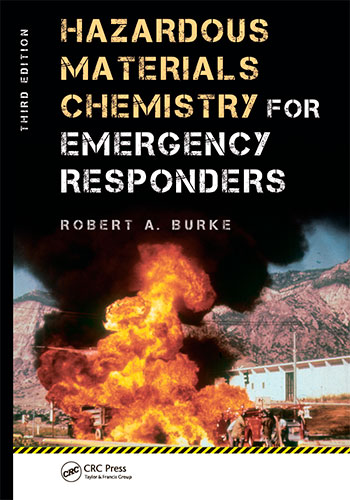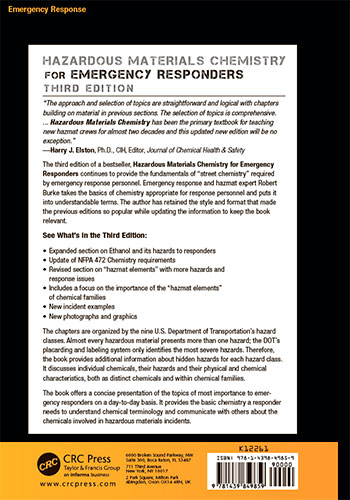Сб с 10 до 16
Hazardous Materials Chemistry for Emergency Responders/Работы аварийно-спасательных служб с опасными химическими веществами
Книга на английском языке.
The third edition of a bestseller, Hazardous Materials Chemistry for Emergency Responders continues to provide the fundamentals of "street chemistry" required by emergency response personnel. Emergency response and hazmat expert Robert Burke takes the basics of chemistry appropriate for response personnel and puts it into understandable terms. The author has retained the style and format that made the previous editions so popular while updating the information to keep the book relevant.
The chapters are organized by the nine U.S. Department of Transportation's hazard classes. Almost every hazardous material presents more than one hazard; the DOT’s placarding and labeling system only identifies the most severe hazards. Therefore, the book provides additional information about hidden hazards for each hazard class. It discusses individual chemicals, their hazards and their physical and chemical characteristics, both as distinct chemicals and within chemical families.
The book offers a concise presentation of the topics of most importance to emergency responders on a day-to-day basis. It provides the basic chemistry a responder needs to understand chemical terminology and communicate with others about the chemicals involved in hazardous materials incidents.
Contents
Preface
Acknowledgments
In memory of Chris Waters
Author
Chapter
1 Introduction
Hazardous materials statistics
DOT/UN hazard classes of hazardous materials
NFPA 704 marking system
Health
Flammability
Reactivity (stability)
Chemical characteristic listings and incidents
Chemical and physical characteristics: Training competencies
OSHA 1910.120
Awareness
Operations
Technician
Incident commander
Review questions
2 Basics of chemistry
Periodic table of elements
Elements
Atomic number
Atomic weight
Hazmat elements
Hydrogen
Lithium
Sodium
Potassium
Beryllium
Magnesium
Calcium
Barium
Titanium
Chromium
Manganese
Iron
Cobalt
Copper
Silver
Gold
Zinc
Mercury
Boron
Aluminum
Carbon
Silicon
Nitrogen
Phosphorus
Arsenic
Plutonium
Oxygen
Sulfur
Fluorine
Chlorine
Bromine
Iodine
Uranium
Helium
Neon
Argon
Krypton
Xenon
Lead
Compounds and mixtures
Solubility
Atom
Formulae
Ionic bonding
Covalent bonding
Salts
Binary salts
Complex ions (polyatomic
Oxysalts
Cyanide salts
Ammonium salts
Inorganic nonsalts
Binary nonsalts
Nonmetal oxides
Binary acids (inorganic acids
Oxyacids (inorganic acids
Inorganic cyanides
Nonmetal compounds
Physical and chemical terms
Review questions
3 Explosives
Definition of explosion
Categories of explosions
Phases of explosions
Mechanical overpressure explosions
Mechanical/chemical explosions
Chemical explosions
Dust explosions
Nuclear explosions
Components of a chemical explosion
Types of chemical explosives
Forbidden explosives for transportation
Types of chemical explosions
Explosive effects
Yield vs. order
Division 1.1–1.3 explosives
Explosive families of compounds
Inorganic explosive compounds
Metal azides
Aliphatic explosive compounds (nitro hydrocarbon derivatives)
Aromatic explosive compounds
Incidents
Explosives subclasses 1.4–1.6
Explosive chemicals
Incidents
Homemade explosives/terrorist explosives
Military explosives
Summary
Review questions
4 Compressed gases
Flammable gases
Flammable range
Vapor density
Hydrocarbon families
Alkanes
Isomers
Alkenes
Common alkenes
Alkynes
Hydrocarbon derivatives
Incidents
Nonflammable compressed gases
MRI and NMR facilities
Hydrocarbon derivatives
IncidentsPoison gases
Incidents
Summary
Review questions
5 Flammable liquids
Effects of temperature on flammable liquids
Boiling point
Factors affecting boiling point
Flash point
Ignition temperature
Flammable range
Vapor pressure
Vapor content
Vapor density
Specific gravity
Polymerization and plastics
Animal and vegetable oils
Fire-extinguishing agents
Hydrocarbons
Isomers
Cyclic alkanes
Hydrocarbon derivatives
Alkyl halide
Amines
Ethers
Alcohol
Isomers
Ketone
Aldehyde
Esters
Organic acids
Other flammable liquids
Incidents
Review questions
6 Flammable solids
Class 4.1 flammable solids
Flash-point solids/sublimation
Flammable particles and dusts
Class 4.2 spontaneous combustibles
Pyrophoric solids and liquids
Incidents
Class 4.3 dangerous when wet
Incidents
Fire-extinguishing agents
Review questions
7 Oxidizers
Class 5.1 oxidizers
Oxysalts
Peroxide salts
Inorganic acid oxidizers
Other oxidizer compounds
Incidents
Class 5.2 organic peroxides
Incident
Review questions
8 Poisons
Types of exposure
Routes of exposure
Effects of exposure
Short-term effects
Long-term effects
Etiologic effects
Variables of toxic effects
Dose/response
Susceptible target organs
Exposure rate
Defense mechanisms for toxic materials
Toxic elements
Toxic salts
Toxic hydrocarbons
Toxic hydrocarbon derivatives
Alkyl halides
Amines
Cyanides and isocyanates
Alcohols
Aldehydes
Organic acids
Phosphoric esters
Miscellaneous toxic materials
Pesticides
Other toxic materials
Military and terrorist chemical agents
Chemical agents
Nerve agents
Antidotes
Mustard agents (vesicants)
Blood agents (cyanogens
Choking agents (lung-damaging agents)
Riot-control agents (irritant agents and vomiting agents)
Vomiting agents
Miscellaneous chemical agents
Infectious substances
Bacterial agents
Viruses
Toxins
Chemistry of clandestine drug labs
Summary
Review questions
9 Radioactive materials
History of radiation
Types of radiation
Isotopes
Regulation of radioactive materials
Intensity of radiation
Radiation exposure
Radioactive elements and compounds
Uranium compounds
Radium compounds
Cobalt
Iodine
Krypton
Radon
Department of Energy Nuclear Emergency Search Team
Review questions
10 Corrosives
Inorganic acids
Strength and concentration
pH
Organic acids
Dilution vs. neutralization
Incidents
Review questions
11 Miscellaneous hazardous materials
Elevated-temperature materials
Other miscellaneous hazardous materials
Incidents
Review questions
12 Incompatible and unstable chemicals
Acids and bases
Oxidizers and organic materials
Aging chemicals
Unstable functional groups
Water- and air-reactive materials
Basic chemical storage segregation (Tables 12.6 and 12.7)
Appendix
Glossary
References




